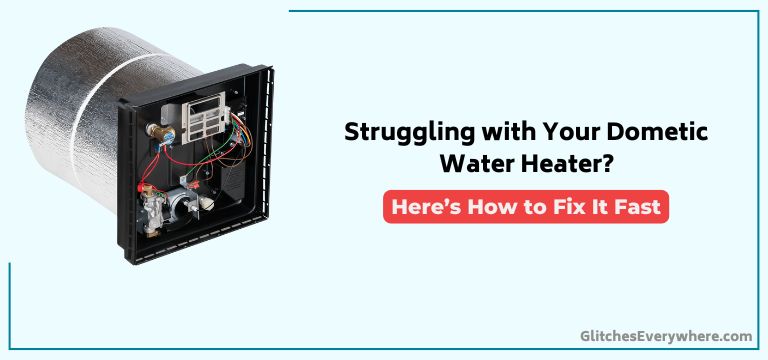The Dometic Water Heater is a great device, but like all electronics, it sometimes has its issues. If your Dometic Water Heater is not working, take a look at this troubleshooting guide.
We’ve collected answers to the most frequent reasons you’ll see Dometic Water Heater not working and explained them in plain language for easy troubleshooting.

Quick Fix
To troubleshoot a Dometic water heater, check the power supply and gas connection, ensure the thermostat is set correctly, clean the burner and ignition assembly, and inspect the anode rod and tank for corrosion or leaks.
Understanding Your Water Heater
When you’re dealing with issues in your RV’s water heater, understanding how it works is crucial to effective troubleshooting.
Your Dometic water heater, a 6-gallon gas/electric unit, relies on a control board to manage its operations.
The control board receives 12-volt power and directs it to the Fixed-Temperature Thermostat (T-STAT) and thermal cut-off fuse.
The electric switch and gas valve are also controlled by the board.
The electric heating element relay switch closes when the tank water is below 140 degrees, allowing 115 volts to flow to the heating element.
Certify your voltage is at least 10.5 DC volts for proper operation.
If not, you may have a faulty propane switch, 12-volt fuse, or battery.
Troubleshooting Electric and Propane
Most Dometic water heater issues stem from either the electric or propane components, and addressing these problems requires a thorough understanding of their interconnected systems.
When troubleshooting the electric side, you’ll want to focus on the circuit board, which sends 12-volt power to the thermal cut-off fuse and the Fixed-Temperature Thermostat (T-STAT).
The yellow wire should send 12 volts to the electric heating element relay switch when the tank water is below 140 degrees. If the thermal fuse is damaged, it won’t read 12 volts with power on.
On the propane side, guarantee the gas valve receives at least 10.5 DC volts to operate properly.
Testing and Identifying Issues
When testing the Dometic water heater, you’ll need to perform several voltage checks to identify issues.
You’ll want to measure the voltage at the heating element, ECO switch, and propane gas valve to verify they’re receiving the proper voltage.
Voltage Checks
To guarantee your Dometic water heater operates efficiently, voltage checks are essential to identify potential issues before they become major problems.
You need to confirm the minimum required voltage of 10.5 DC volts is met for proper operation.
- Check the orange wire at the control board, which should read at least 12 volts to certify proper operation of the water heater’s electrical components.
- Test the brown wire at the T-Stat module, which should read around 12 volts to verify the thermal cut-off fuse is functioning correctly.
- Verify the red wire at the control board has at least 10.5 volts to send power to open the propane gas valve.
Thermal Fuse Testing
Your Dometic water heater’s thermal fuse is a critical safety device that automatically shuts down the system in the event of a fire in the outside compartment. Located in a semi-clear tube with crimped on spade male and female ends on the leads, it’s essential to check the red wire connector end for corrosion regularly. Apply antioxidating grease/paste to the circuit board plugs to prevent corrosion.
To test the thermal fuse, use a multimeter to check for voltage across the thermal cutoff and fixed temp cont t-stat. This will help you diagnose issues. If you find problems, replacing the thermal cutoff can resolve them. It’s a good idea to carry spare thermal cutoffs for future repairs.
| Component | Description |
|---|---|
| Thermal Cutoff | Automatically shuts down the system in case of a fire |
| Fixed Temp Cont T-Stat | Thermal type switch that can fail due to flame extension |
| Eco Switch | Thermal type switch that can fail due to flame extension |
| Thermal Fuse | Critical safety device that shuts down the system in case of a fire |
| Multimeter | Tool used to measure voltage across components |
Component-Specific Troubleshooting
You’ll now focus on troubleshooting specific components of your Dometic water heater.
Start by testing the Thermal Cut-Off fuse with power on, checking for a 12-volt reading to guarantee it’s not damaged.
Next, you’ll examine the Electric Heating Element and Propane Gas Valve, verifying proper voltage on the yellow and red wires, respectively, to certify potential issues.
Thermal Cut-Off Testing
Most Dometic water heater issues can be traced back to a faulty thermal cut-off fuse, which is a critical safety device designed to shut down the system in case of a fire in the outside compartment.
To test the thermal cut-off fuse, you’ll need to check for continuity with a multimeter.
- Check the voltage on the brown wire coming out of the board, which should read around 12 volts.
- Verify the thermal cut-off fuse is getting power by checking the voltage at the T-Stat module, which should also read around 12 volts.
- Use a multimeter to test the thermal cut-off fuse for continuity, ensuring it’s not damaged and preventing the propane gas valve from opening.
Electric Heating Element
One of the most critical components in a Dometic water heater is the electric heating element, which converts electrical energy into heat.
You’ll find it submerged in the tank, usually at the bottom. Check the heating element for signs of damage, corrosion, or mineral buildup. Verify the wire connection is secure and not loose.
If you notice any issues, replace the element to prevent further damage to your water heater. A faulty heating element can lead to reduced hot water supply, increased energy bills, or even complete system failure.
Guarantee the thermal cutoff is functioning correctly to prevent overheating, which can damage the element. By inspecting and maintaining the electric heating element, you’ll extend the lifespan of your Dometic water heater and enjoy a consistent hot water supply.
Propane Gas Valve
When your Dometic water heater is powered by propane, the gas valve plays a vital role in regulating the flow of fuel to the burner.
This component is critical for a seamless RV Life experience. If you’re experiencing issues with your propane-powered water heater, it’s essential to inspect the gas valve.
- Faulty gas switch: Confirm the gas switch is functioning correctly, as a faulty switch can prevent the gas valve from opening.
- Incorrect gas valve settings: Verify that the gas valve is set correctly for your specific water heater model. Consult your user manual for guidance.
- Blockages or debris: Inspect the gas valve for blockages or debris that may be obstructing the flow of propane, affecting the performance of your gas and electric water heater.
Repair and Maintenance Essentials
While troubleshooting your Dometic water heater, it’s essential to start with the basics of repair and maintenance to guarantee you’re addressing the root cause of the issue.
Understanding the wiring diagram of your 6-gallon gas/electric unit is pivotal for effective troubleshooting.
When testing the propane side, you’ll need a multimeter to measure DC and AC voltage as well as continuity.
Verify the minimum required voltage of 10.5 DC volts is present; if not, the propane switch, 12-volt fuse, or battery might be faulty.
Regular maintenance is also pivotal; inspect the thermal fuse and clean the porcelain spark rod insulator with alcohol to prevent issues.
Safety Precautions and Best Practices
Before you begin troubleshooting your Dometic water heater, make sure you’re taking the necessary safety precautions to avoid injuries and damage.
You’re working with electrical and water systems, which can be hazardous if not handled properly.
To guarantee your safety, follow these best practices:
- Turn off the power: Switch off the water heater’s power supply at the circuit breaker or fuse box before attempting any repairs.
- Access the panel safely: Verify the access panel is securely fastened to prevent it from falling off while you’re working underneath.
- Disconnect the water supply: Turn off the water supply valves to prevent water from flowing into the heater while you’re troubleshooting.
Common Issues and Solutions
You’re likely troubleshooting your Dometic water heater because it’s not functioning as expected.
One common issue is the Dometic GC6AA-10E’s electric heating element not turning on. Check if the water temp is below 140 degrees, and verify the relay switch is closing to allow 115 volts to flow to the heating element.
Another problem is the propane gas valve failing to open due to low voltage (less than 10.5 DC volts). Inspect the thermal fuse‘s red angled connector for corrosion, which can cause intermittent issues.
Regularly clean the porcelain spark rod insulator and thermal fuse connections to prevent unexpected failures.
Finally, test the system by flipping on the heater gas mode and listening for the gas valve’s clunk and igniter’s click to diagnose issues in the safety circuit or PC board connection.
Frequently Asked Questions
Where Is the Reset Button on RV Dometic Water Heater?
You’ll typically find the reset button on your RV’s Dometic water heater hidden behind a removable panel or in a compartment near the thermostat. Check for faulty thermostats, electrical issues, or installation errors that may require a reset.
How to Reset RV Hot Water Heater?
“When in doubt, start from scratch” is a good rule to follow when troubleshooting. To reset your RV hot water heater, first verify cold water is flowing, then check for high pressure, faulty thermostat, incorrect installation, or corrosion buildup, and address these issues before guaranteeing.
What Is the Most Common Cause of Water Heater Failure?
You’ll find that corrosion issues, often caused by thermal expansion and sediment buildup, are the most common cause of water heater failure, making regular leak detection and pressure relief valve checks vital to prevent costly repairs.
Why Is My RV Hot Water Heater Clicking but Not Lighting?
As you stand in your RV, waiting for a warm shower, the clicking hot water heater taunts you, refusing to ignite. It’s likely due to a faulty thermocouple, igniter malfunction, gas supply issue, spark module failure, or electrode corrosion – all common culprits behind the frustrating clicking sound.
Conclusion
As you wrap up your troubleshooting journey, bear in mind that a well-maintained Dometic water heater can last up to 15 years, with some units logging over 20,000 ignition cycles – that’s equivalent to taking a hot shower every day for 55 years! By following these guidelines, you’ll be well-equipped to tackle common issues and guarantee your water heater runs efficiently and safely. Now, get out there and troubleshoot like a pro!
Table of Contents

